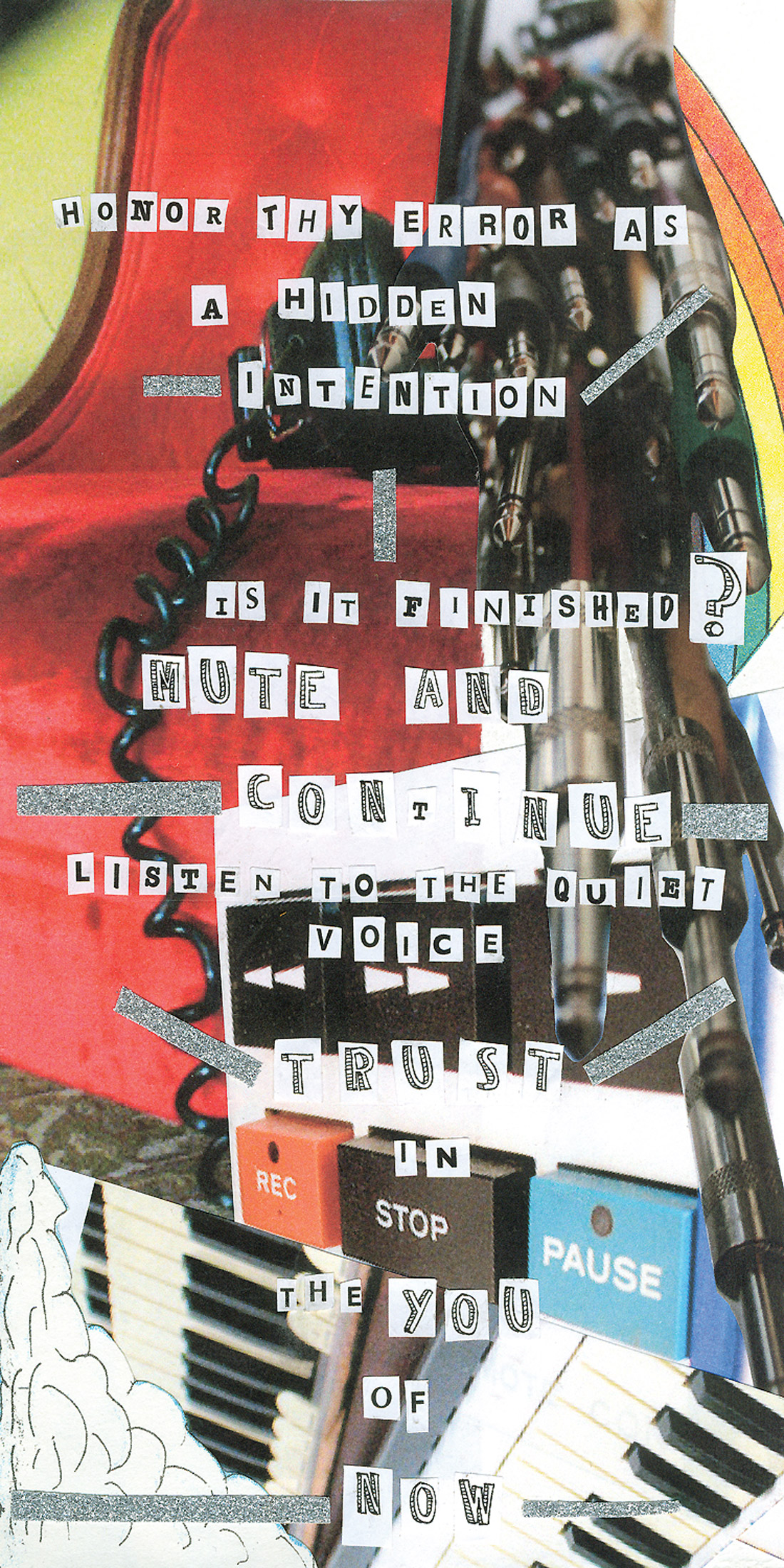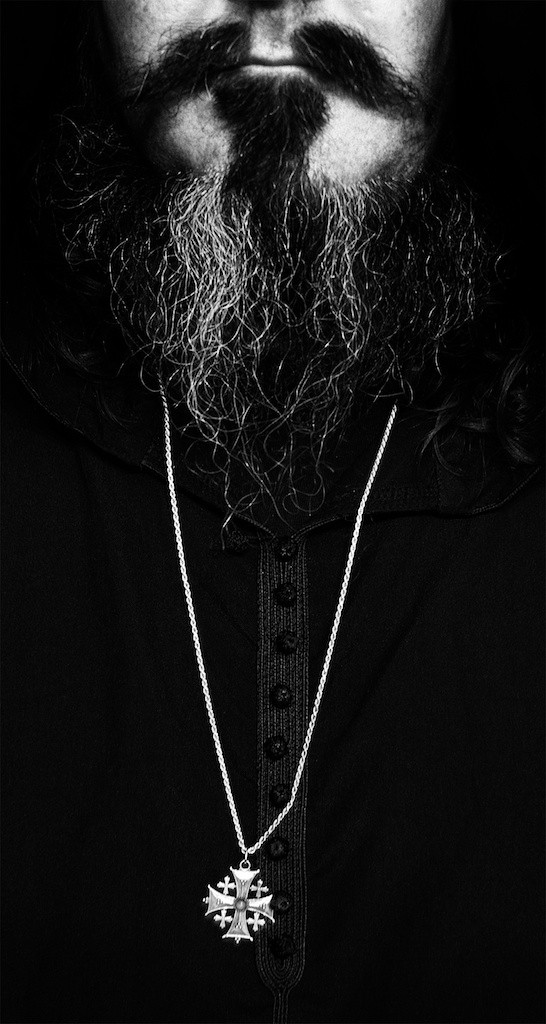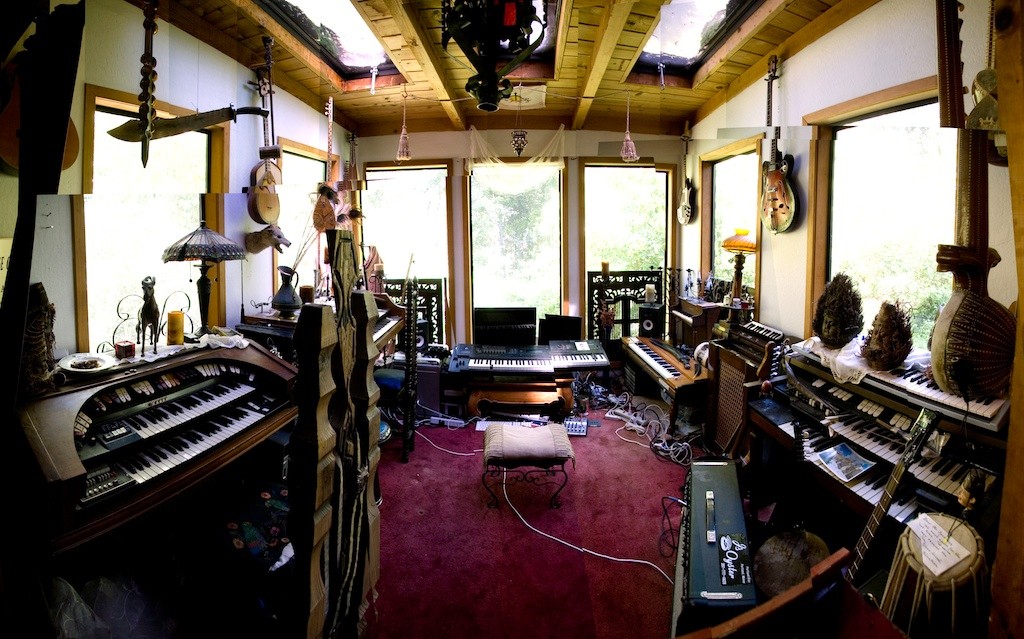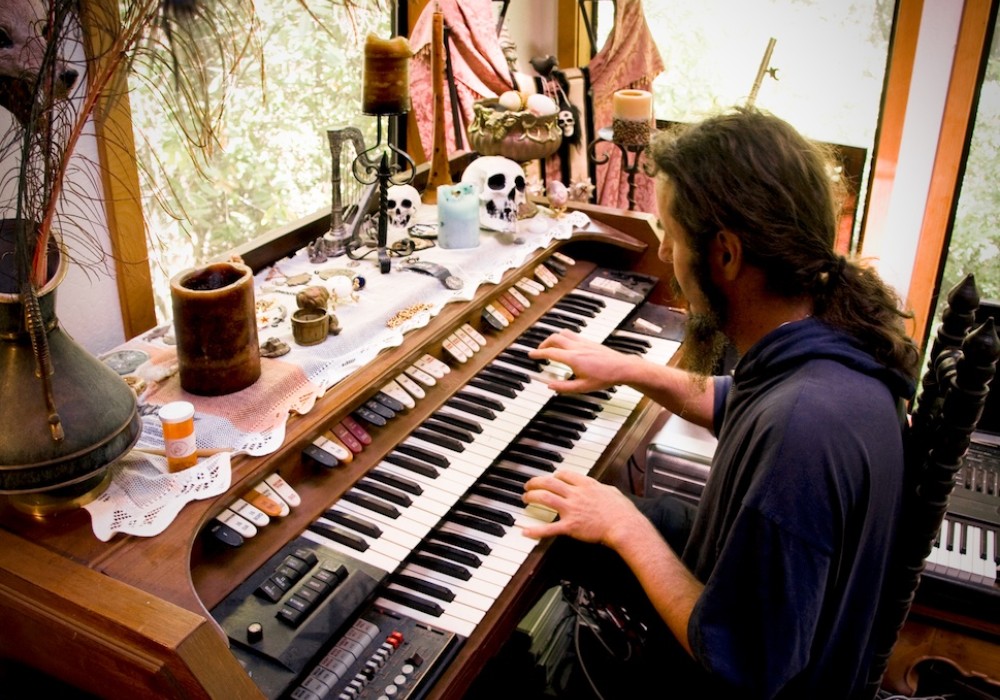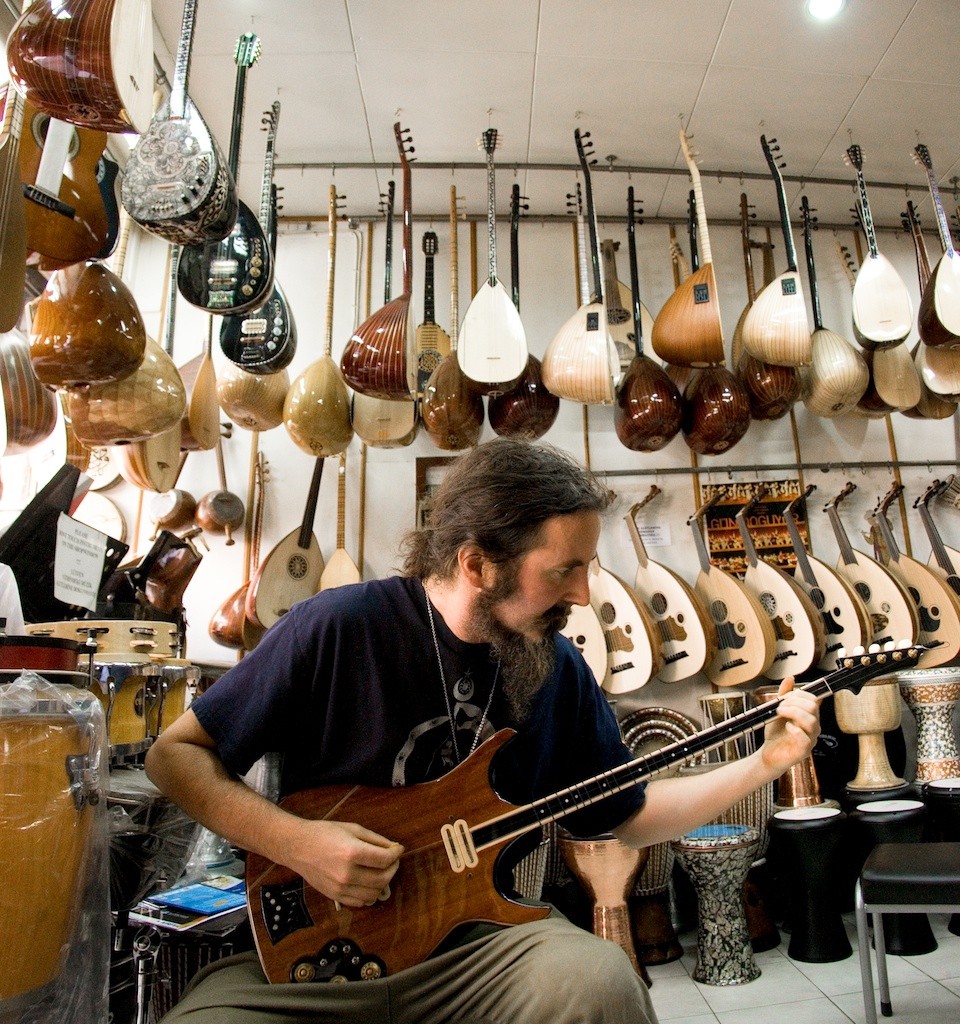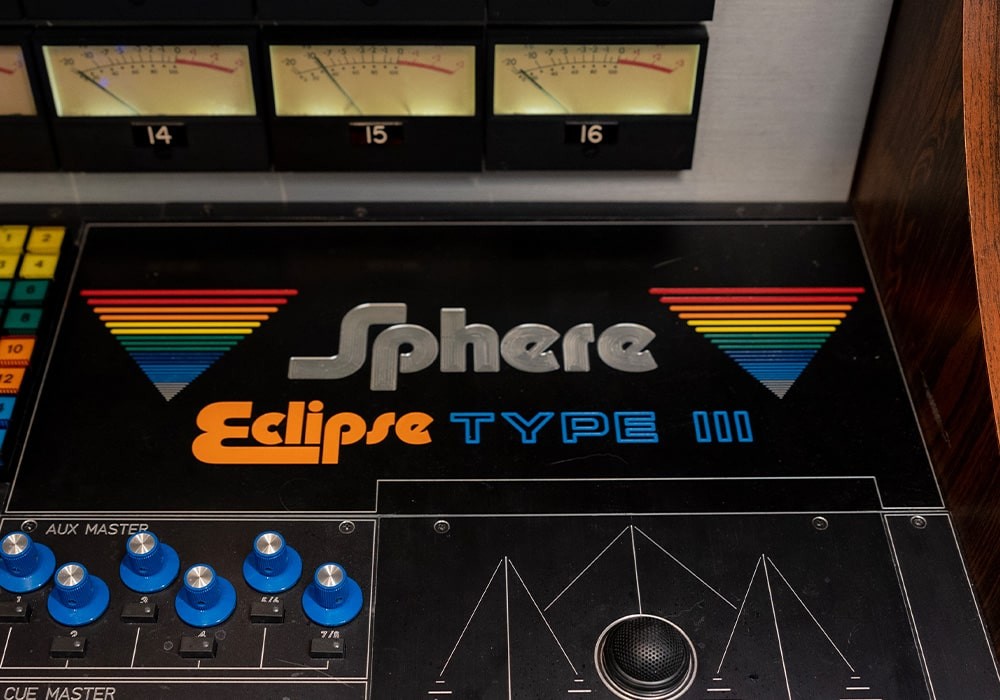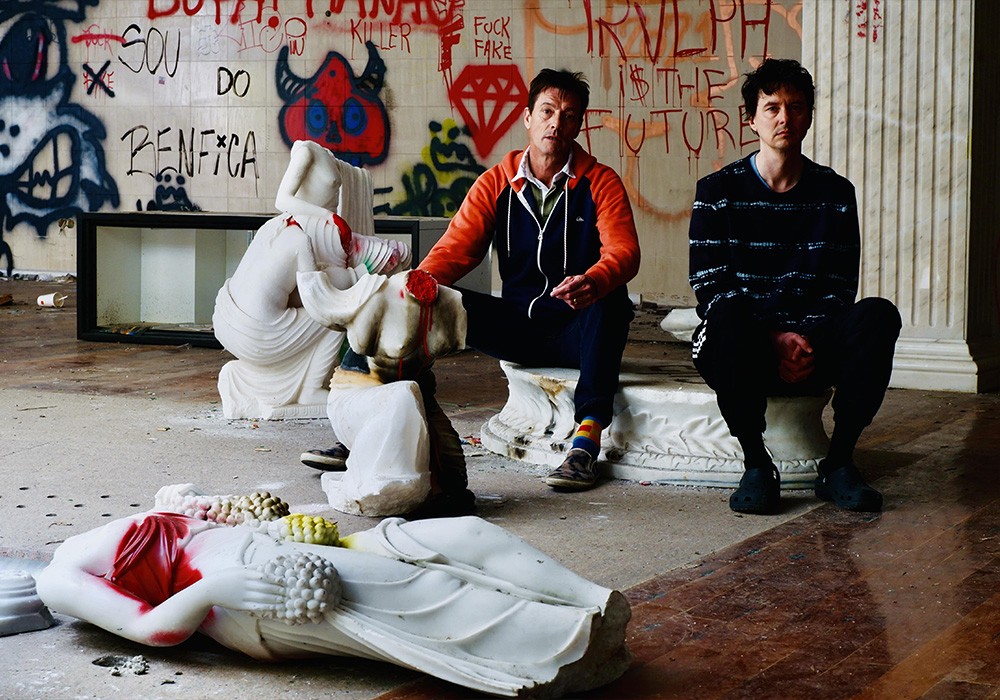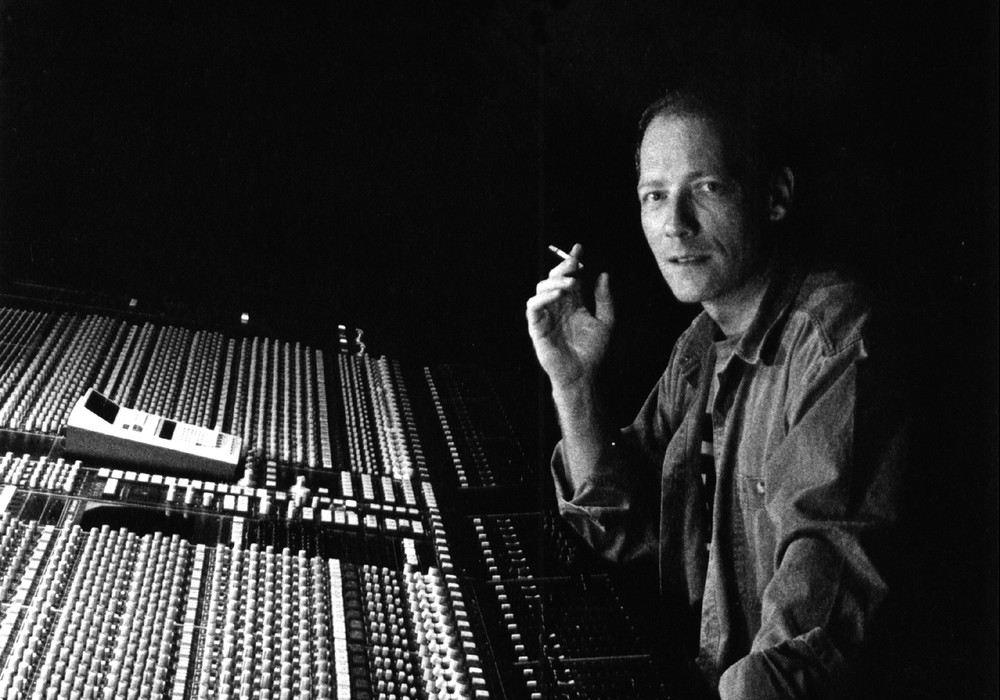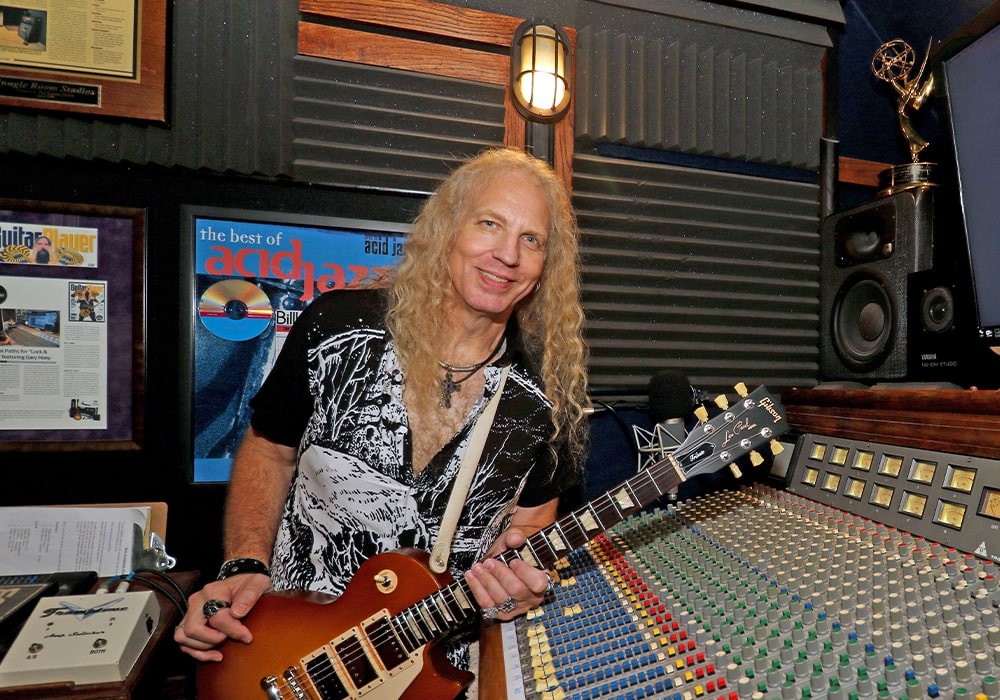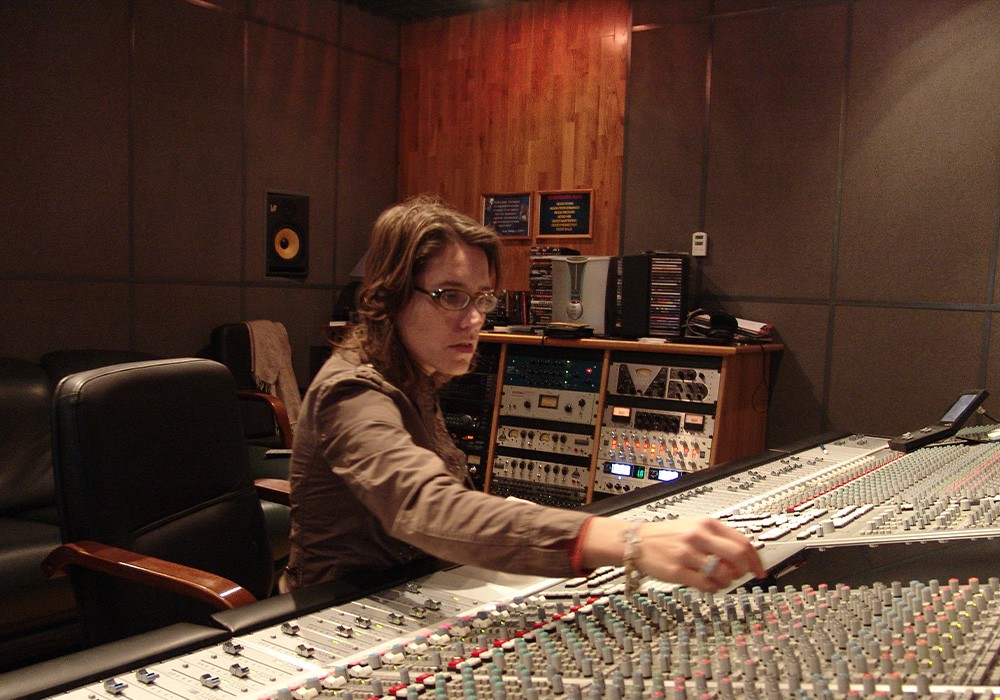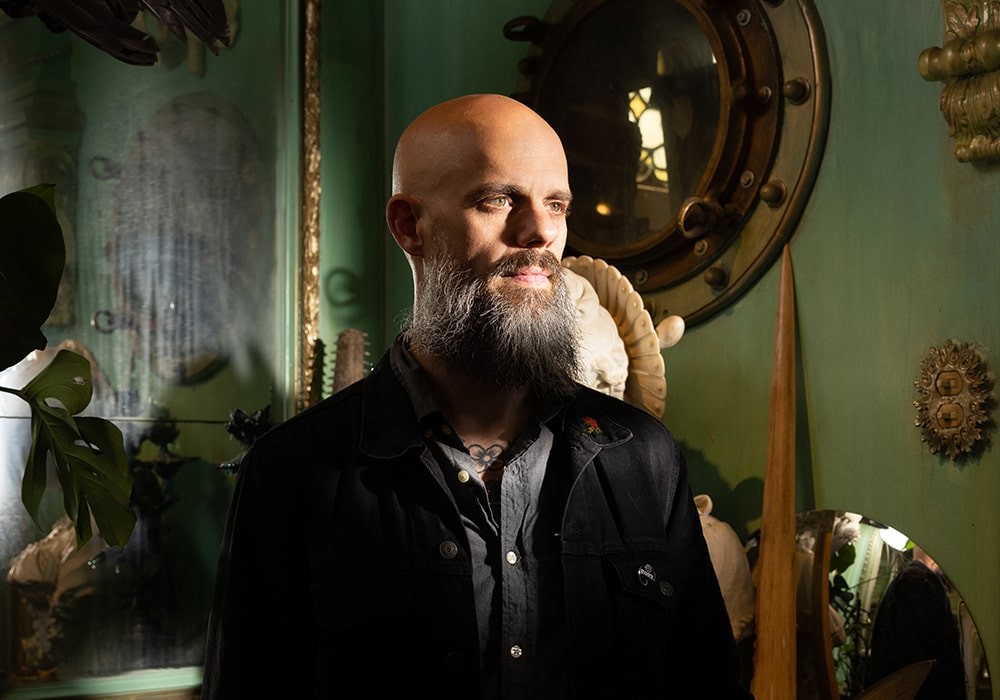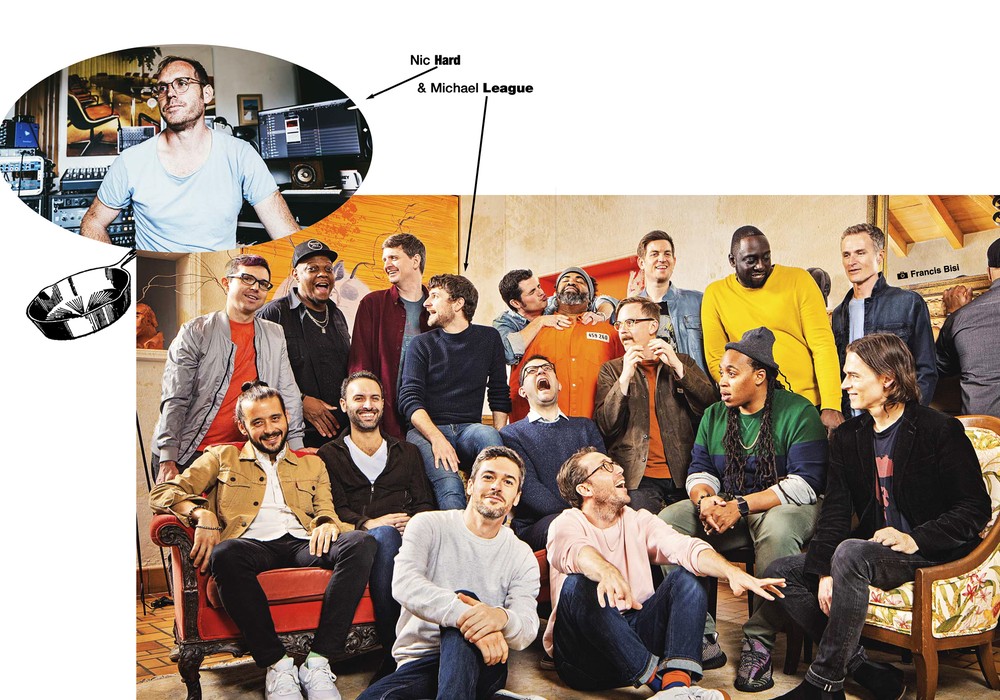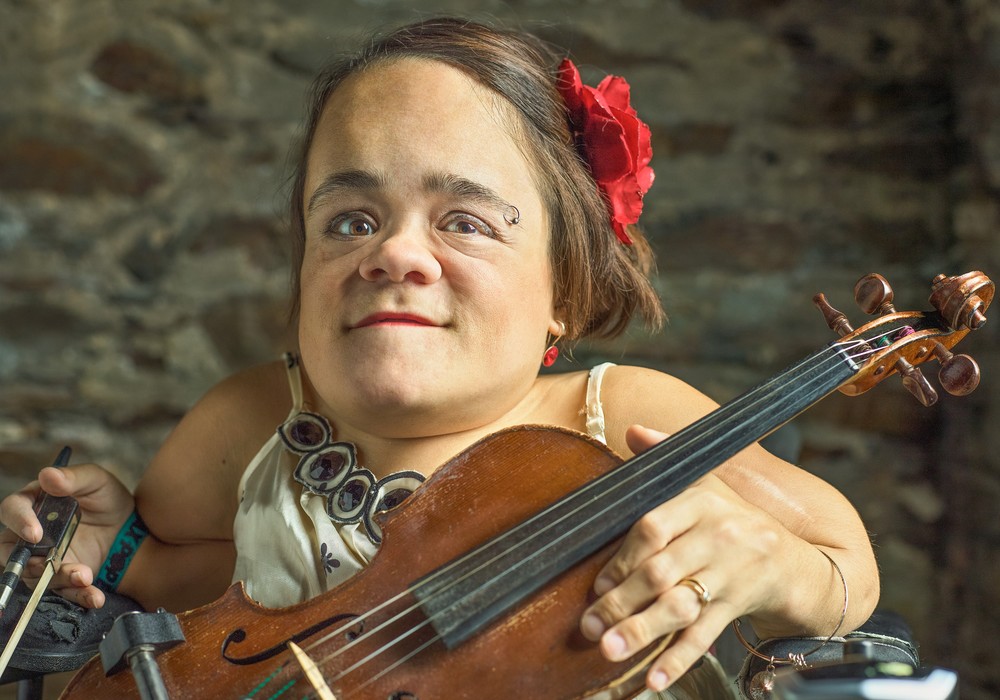If you spend some time around Trey Spruance, it's not uncommon to hear him expounding on Islamic theologians, geopolitics or holes in the Big Bang Theory. Yet Trey is better known not for his encyclopedic abilities, but for his former band Mr. Bungle and current project Secret Chiefs 3.
Trey's most under-appreciated talent, however, is his masterful engineering ability. He started recording by tracking his high school band, Mr. Bungle, on a Tascam Porta One 4-track cassette recorder. When they were signed to Warner Bros. Records, Trey seized the opportunity to learn as much he could. He befriended engineer Billy Anderson [Tape Op #33], who taught him the ins and outs of studio recording. By Mr. Bungle's third record, they were linking three 24-track, 2-inch tape machines and two ADAT machines together to accommodate their ever-expanding orchestrations. At the same time, Trey had been tracking his other project, Secret Chiefs 3, in Bungle's rehearsal space. While Secret Chiefs 3 share Mr. Bungle's extensive orchestration and track density, they didn't have the same extensive recording budgets. This forced Trey to develop creative solutions to realize his musical visions in his home studio. Many records later, he has cultivated a set of surprisingly original techniques for getting the most out of home-recording and professional studios.
I've heard that you really pushed some crazy limits of the studio with Mr. Bungle.
Our track sheets became these skyscrapers. It was a group effort of everyone — I was essentially keeping track of what was possible. Billy [Anderson] was saying, "If it's possible, let's do it." He's very intuitive about stuff, like setting an [Universal Audio] LA-2A, for instance, he will literally put an [AKG] C 12 in the room, it's all the way on, completely crushed, or maybe we'll back off a little bit, but that's what we're using it for. Why use the LA-2A to do half of what you wanted to do? Use it to do all of what you wanted it to do and then back off if you need to. [laughing] I really, really appreciate that approach. It's milking every unit for what it's worth. It worked for us because we were very careful about what the tone should be. No one in Mr. Bungle knew enough technically, but we'll fuck with it until it's right. Between Billy's more cavalier intuitive approach, me becoming more and more tech meticulous and the band scrutinizing everything really carefully, it's a good mix. This is when I started planning out for panning, permanent panning locations. Same idea as starting with your faders flat. I started developing this thing of making stereo pairs and then on input having things be in their panning orientation. In other words, let's say you have a percussion track, and you know you want it to be at 10 o'clock, and you have two channels set aside for percussion and other random things and there's nothing going on at that point. Then on input, you take that percussion track and put it in there on two channels at 10 o'clock. You never have to touch the panning knob. It's going to mix itself from that point forward. Panning location and its gain. A guitar or something similar should be exactly opposite at 2 o'clock. So they live in those panning locations forever. And then you have these nice pairs that you can send to your outboard gear when you mix, in pairs.
But then you changed your approach with Book M.
Well, sort of. I got a PC laptop. A Quantex, 10 gig, black monster that had a PCMCIA slot and Samplitude 3. I found a Korean company called Ego-Sys, that at the time was creating this thing called a WaMi Box — this breakout box that had S/PDIF in on it, which enabled me to hook it into my HHB Portadat, which had really good preamps. The chain was crazy: [AKG] C 414s into my Telefunken V72s, into the HHB DAT, engage the record head and then run the S/PDIF into the WaMi Box and into the laptop. And this was a portable setup. I took it with me on tour with Mr. Bungle and recorded a lot.
How did you do that??
This is embarrassing: With the very first [Line 6] POD. We went to a studio with the drums and bass and I added the guitar parts later. The clean guitars were on the Fender Twin. That's not portable. It's not like you have more than 16 tracks to work with before it starts choking. This is all to the credit of Samplitude.
Can you explain how you're using stereo pairs now, both at home and then when you bring it to mix?
Since it's just me having the final say in the mixes, that's the reason it works. Since I know what it's going to be, I can decide that ahead of time. It demands more creative flexibility in a band like Mr. Bungle where you have to leave questions like that open ended. I'll wait until the final stage to assemble things into pairs and group the outputs. You go into a mixing board out of 8 channels. Drums usually take up one [stereo pair], an assortment of other things going to two stereo pairs, and then usually keyboards and guitar sharing one pair. It's mostly whatever EQ would be applicable over the spectrum of one group so you wouldn't have interference. Nothing where high mids and low mids are sharing the same thing. Either very wide contrast in frequencies or generally living in the same... sharp attacks will all go in the same, because of the way they hit the compressor and more legato things will go in another one. Strings and certain kinds of keyboards will go together, like pad stuff. More attacky keyboards and clavinets will go with the guitars and percussion.
You're making stereo pairs with auxes?
Either that or just coming straight out the channel. I think the only difference that I'm doing now is slimming back the idea of automating every single channel independently, which is what I did on Book of Horizons. It's completely crazy.
Why is that?
Why is it crazy? Because there are 140 tracks! You scroll down the view of all the tracks and it just goes on and on, and if you zoom in a little bit on any of them there's all this automation editing. Like the threshold on the compressor changing over the course of the song, panning, volume... Everything is being fucked with track by track by track. A lot of that is pointless. I could have just sent all of those things to an aux, and done that one time. That's madness. But I learned from it. So much of that stuff is making up for the fact that you're not in analog. In the analog realm I don't have this fetish that it should sound so warm and so great. To me it should sound like this. When you're working in digital, it doesn't, and you have to put all that meticulous work in. It's never satisfying to me to use a tape saturation plug-in, or even going back out into analog. It doesn't help anything unless you've done the work to get it to sound right. The mere fact that you're in digital makes certain things stick out that you have to manage and make room for the other things. If there are little moments when you have to hear the other things, I'm sorry, but those moments have to be automated. You have to poke their head out of the digital cloud. It's necessary work that has to be done in order to make it out of the trappings of the digital format. Making it sound what you know in your head it should sound like is easier to achieve in analog. But it's not because analog is this warm, wonderful thing. It's because it happens to capture the human intention better than digital. You can do it with digital, but you have to work fucking hard. Book of Horizons would have cost easily a quarter of a million dollars to do in the analog realm. Probably more. But it cost me $3000 to do, just because I was willing to sit there for two years stitching. [laughs] But I made a massive mistake! I bounced to disk. Can you believe that? I could have just taken my stuff to somebody's house and recorded it into their setup, but I decided, "Fuck it. I'll just bounce to disk." That was a mistake.
What was lost?
A punch to it. When I bring up those files now on my computer, the raw files have so much more depth. So much more resolution and clarity. A lot was lost in the bounce to disk. A lot. I worked absurdly hard at the final stage. Every time I would get the mix done, do the bounce to disk, hear what was wrong with it, set things on the limiter differently and automate them episode by episode.
But Book of Horizons was mastered, wasn't it?
No.
You "mastered" it in the mix?
Every little detail by every little detail. Every time I would do a bounce to disk, I would take notes on exactly what needed to be fixed, go back, fix it in the gain structure of the whole track and try it, try it, try it. It would turn out different every time. The bounce to disk was always different than what you were hearing.
What kind of changes were you making?
Reducing reverbs a lot of the time because it would emphasize undesirable reverbs. Decreasing input gain toward the beginning of a tune and increasing the volume, and having those two things trade places by the end of the track. There's a tendency in Secret Chiefs songs to build up and become climatic toward the end, which always dwarfs the next tune, so I developed this concept of trading gain for volume. It also helps get clarity out of the mixes. If you start some of those songs on that album during the last quarter of it, it will sound really muddy and weird, but you don't notice this when you start from the beginning because you're already invested in the song. In that thing of achieving the climax, which is a psychological/emotional sort of thing, one of the things that gets sacrificed is clarity and resolution. But it has to be there to have the right sort of emotional/psychological impact. Decreasing gain and boosting volume at the beginning and then actually crushing it towards the end but turning it down so that it can ramp into the next song without totally obliterating it turned out to be the solution. The ear doesn't perceive any changes. You're not really noticing the fact that these things are trading places. You do effectively manage the volume problems. You can go right up to the ceiling by the end, or so you think, but you're not. You're actually down 2 dB. So when the next song starts, it's not completely dwarfed. It's totally psychological — a psychoacoustic thing. And that's counterintuitive.
After every mix, each song sounded the way it should relative to the other songs?
I leave myself three weeks to deal with that issue because it's a big one. This is how you're ingratiating yourself to the listener. This is how you're handing it to them. Like the way the food is being laid out. It's prepared, but how you present it is really important. I feel it's a matter of common courtesy. That part of the process is all for the listener. The person that's never heard it before, the person who will listen to it three times or the person who will listen to it 100 times. Those are the people you're thinking about in that stage.
Are you recording in 24-bit/96 kHz now?
Yeah, and I don't know how worth it that is. It is if you're working with a mere 50 tracks, like on the Le Mani Destre Recise Degli Ultimi Uomini album, you can mix it to tape and everything is wonderful. But if you're working with 140 tracks, I'm not convinced that it matters. You're not really working with fidelity. You're manipulating people's consciousness through a bunch of things moving around. I would love to think that if I recorded everything in an East German studio in 1969, that it would all sound like those recordings, but it wouldn't. I have too much shit going on. With high fidelity recordings, and really caring about tone on stuff, it makes sense when there are less instruments. Not to say that I don't care about it. I'll work on it, but I've also realized it matters a lot less if you have 40 violins and they're all being tracked by one person. What's important is not that you've used a [Neumann] M49 and got the settings exactly right on the [Neve] 1272. What's important is, did he move and pretend that he was a different kind of person with a different position on the microphone? Did I change to a Royer microphone to give a different variety on the second course of eight violins, so that I don't have a stack up of frequencies from the M49? It's more important to have a variety of things that make it into a believable session, than to sit here and obsess over the fact that you've used this great $20,000 microphone on 50 tracks of the same thing. That's not high fidelity. That's nonsense! [laughs] It's true! What you're going for is a final result, what a sound should be, and if what you're trying to do is get an ensemble, it's more about the psychology of the player, their proximity to the microphone and the variety of frequencies, not the badass incredible gear that you're using. That works with one violin or three. Not 50.
Can you expand more on emulating different players to sound like a full orchestra?
There's two parts to it. The great thing about classically trained players is that all of them have played in orchestras, so they've sat next to the annoying person who's in the second violin section, who's pissed off that they're not in the first violin section, the person who's kissing ass to the concert master. He can go into that mindset, now I'm this person. I play a little bit lighter, this note a little bit out of tune because I just have this annoying tendency. Okay, next take! Now I'm the guy that plays too fucking loud that everyone hates... It's changing your psychological profile every time you're doing it. That takes care of some of the stuff. It's great if the person that you're overdubbing has a selection of instruments, even inferior ones. Almost half of them should be on the shittier violin that has a different frequency make up. If they're all tracked on that one violin, you're going to have to EQ half of them differently. It's better to have an inferior instrument than EQ a good one. So then it still doesn't sound like a section, it still sounds like someone's overdubbed themselves a million times even though you've dealt with most of the issues. How do you get them into a space that sounds like something other than your bedroom? Some digital reverbs that use modeled spaces, the only thing they're good for, instead of hearing the actual space, you set the room to be really small. You bus all these string tracks into this reverb. All wet, no dry and only early reflections. The fewer the better. Basically you're putting them all in a very small room together. Now you add your plate reverb to them and it sounds like a bunch of violins all together in one section, playing in a big room or through a plate reverb. It really does magically transform the string section. Before the long reverb, the plate, but after the small room, that's your moment that you can compress it just right.
How do you find yourself mic'ing Middle Eastern instruments? Is that any different?
Not if they're electric. Sometimes that's a challenge because no one that I know has experience with that. I just experiment with it. Most of the string instruments, it's definitely the resonant part in front of where you would pick, right where the neck joins the body. That seems to be the best place to mic plucked string instruments of every kind. With the santur I just use logic. Put it over the sound hole. It's pretty straight orward, like mic'ing a piano.
And how do these instruments fit into your concepts of orchestration?
When I listen to Beethoven and hear the way he paired an oboe in this register with a French horn in this register to get this other instrument, this is because he heard that at some point and said "ah!," grabbed that and wrote for it. It's kind of the same thing. You definitely know what's possible and sometimes you have to experiment a little to get there but you know what your musical idea is already. For me orchestration and recording are the same thing when making a record. Sometimes you end up having to use more strings than you thought, or sometimes you get there with five when you thought you'd have to do 11. But all of the musical ideas are known ahead of time. Whether it's detracting from what the "already in your brain" goal is, whether it's leading towards it or going away from it, you catch that right away and know when to stop or to keep going or try something else. Most of my ideas are very simple and the complexity comes in the detail work. Most of the melodies are sing-able melodies over pretty standard chord progressions. Pretty. And then it's the detail work that milks those. I'm really against the idea of convoluting the original idea. I hate it when musicians have a clear and good idea and then accuse themselves of doing something garden variety, "so now I need to go fuck with it." This is terrible. The original, pure idea, maybe needs to be more than what it is, so dress it up in something! Don't be ashamed of how normal it is! That's what orchestration is for me. There might be all these intricate harmonic things going on in the background and that's why on multiple listens you hear things that you've never heard before. And maybe those aren't essential to the strong idea, which is the one you would retain. The magic comes from the simple things. For sure it does.
